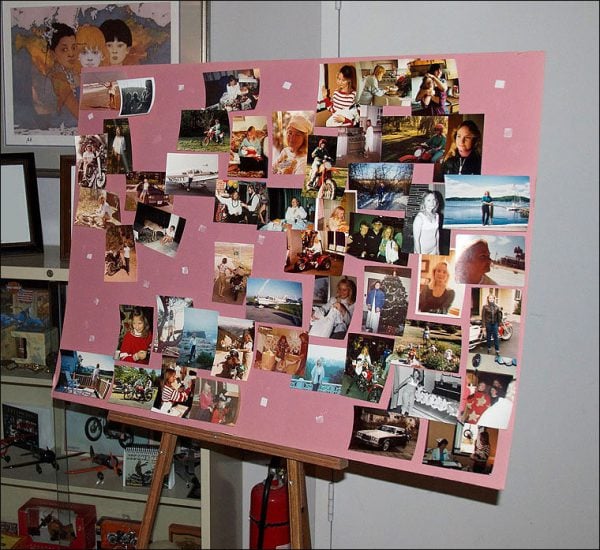Recently I was asked for advice from a friend who had come across a forgotten example of what is today perhaps the most common occurrence of “tape on your photographs”—the family snapshot display. 
Whether or not it’s wise for you to try and remove tape stuck to your photos depends on a host of factors involving both the tape and the type of photograph it’s adhered to. When in doubt, always consult a trained conservator, and for more information please see the list of additional resources at the bottom of this blog.
Today, however, we’re going to take a quick look at something you often can address yourself—preserving photographs taped onto homemade snapshot displays.

This sort of photo display is common at birthdays, graduations, anniversaries, family reunions, and funerals, and they are sometimes stored assembled for sentimental reasons. The problem arises when the event is over, and we’re left with important photos and snapshots, often originals, that were sometimes hastily adhered to cardboard or poster board displays with double-sided tape, masking tape, or duct tape. They’re also frequently stored for years in attics or basements, where storage conditions are less than ideal.


In the images above and below, the snapshot being used as an example has already been carefully removed from the cardboard display it was attached to, and placed face down on a clean, dry work surface. Exercise caution when removing your taped photographs from your display so as not to bend or tear them.

Slowly peel tape in the same direction it was applied and securely hold the opposite edge of the snapshot with your free hand to provide some stability and leverage. While not usually associated with preserving photographs, a regular hair dryer—set on low—can be used to gently and carefully warm the tape to make this step a bit easier.

Once as much tape as possible has been removed from the snapshot, you will probably notice a sticky adhesive residue on the back of the photograph. To address this simply cut a piece of acid-free Archival Paper or Archival Thin Paper slightly smaller than the image in order to place it over the back of your snapshot. Adding this thin acid-free backing will keep the photo from sticking to the scanner you’ll use in the next step, or to the pages of the photo album or to the interior of any enclosure or sleeve in which you may wish to place it when finished.
Before placing the Archival Paper or Archival Thin Paper backing sheet, check for and make note of any important information that was written or printed on the back of the snapshot. In this case the light red Kodak stamp includes the date the image was printed: February, 1981. This information can help you date the snapshot for future reference—and future generations—and is an important aspect of preserving photographs.
In the image above two snapshots were being scanned. The lower snapshot (the white rectangle) has it’s acid-free backing in place and stayed on the scanner platen when the top was opened after scanning. The upper snapshot does not have this backing, and the adhesive residue stuck it to the cover of the scanner. You’ll want to avoid this situation in your photo albums and enclosures.


Once scanned, the snapshot is ready to be placed in a Print Page and album, or into an archival print storage kit, both of which come highly recommended for preserving photographs. If creating an album, Print Pages will fit into any one of a number of different styles of archival binders to be safely stored and enjoyed for years to come.
At the end of the day, preserving photographs taped to your family displays is well worth the effort. And should the need arise to assemble another homemade photo display in the future, you can safely use printouts of your scans so you won’t have to worry about putting your originals in harm’s way ever again.
In closing, we hope you’ll call or email us here at Archival Methods with any additional question you may have on preserving photographs in your family archive. We also hope you’ll take a look at the following blogs and third-party websites for more information on tape and your photographs.
Please click here to see our blog on Conservators: Pros You Should Know
Please click here to see a response to Removing Tape from a Vintage Photograph from the Smithsonian Institution
Please click here to see a short video on Sticky Tape Removal



